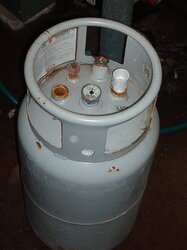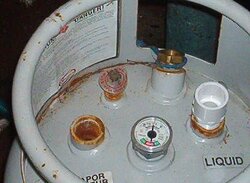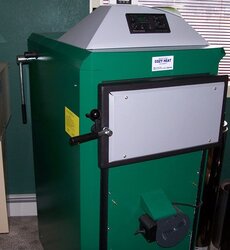I resisted the idea of water storage at first, too, mainly because you can spend upwards of $3,000 for an 800 gallon tank and heat exchangers. Actually, probably more than that now, given the price of copper. And I couldn't see spending that in addition to the cost of the boiler. Plus, I've heated with various conventional wood boilers for about 15 years, and never used storage, except the small amount provided by a 40-gallon water heater.
But--gasification is a slightly different animal from a conventional wood boiler. It has a nice water jacket, but no bed of coals sitting on the grates to constantly generate heat after the fire has died down. The most efficient, cleanest-burning way to run a gasifier, as I understand it, is full-out, balls-to-the-wall. In most applications, that's probably fine without storage when it's below zero (F), but not when it's in the '20s, '30s and '40s. During warmer weather, you're ahead to run it full-out (say) once or twice a day, and store the heat. And in very cold weather, you've got an additional 400,000 btus sitting in the tank in case you need it.
What sold me on the idea, however, was the prospect of firing the boiler up once a week in the summer, banking the heat in the tank, and then living off free DHW for the rest of the week (or however long it takes to deplete the tank). Over time, the cost of the tank comes back in the form of unlimited, free hot water, plus all the additional benefits (mostly in the form of flexibility) that having a hot water storage tank offers.
But the bottom line is that you can run an EKO or a Tarm without hot water storage. I don't know about the Tarm, but they tell me that the EKO will idle well, so it should be fine. If you check out the FAQ at the Horizon website, they say that the only real downside to running without a tank is that you will use more wood. I was going to buy the boiler and think about putting in the tank later, but when I took a hard look at my setup, I decided I could do the tank for around $500. So that's what I'll be doing this weekend.
But--gasification is a slightly different animal from a conventional wood boiler. It has a nice water jacket, but no bed of coals sitting on the grates to constantly generate heat after the fire has died down. The most efficient, cleanest-burning way to run a gasifier, as I understand it, is full-out, balls-to-the-wall. In most applications, that's probably fine without storage when it's below zero (F), but not when it's in the '20s, '30s and '40s. During warmer weather, you're ahead to run it full-out (say) once or twice a day, and store the heat. And in very cold weather, you've got an additional 400,000 btus sitting in the tank in case you need it.
What sold me on the idea, however, was the prospect of firing the boiler up once a week in the summer, banking the heat in the tank, and then living off free DHW for the rest of the week (or however long it takes to deplete the tank). Over time, the cost of the tank comes back in the form of unlimited, free hot water, plus all the additional benefits (mostly in the form of flexibility) that having a hot water storage tank offers.
But the bottom line is that you can run an EKO or a Tarm without hot water storage. I don't know about the Tarm, but they tell me that the EKO will idle well, so it should be fine. If you check out the FAQ at the Horizon website, they say that the only real downside to running without a tank is that you will use more wood. I was going to buy the boiler and think about putting in the tank later, but when I took a hard look at my setup, I decided I could do the tank for around $500. So that's what I'll be doing this weekend.





 !!
!!